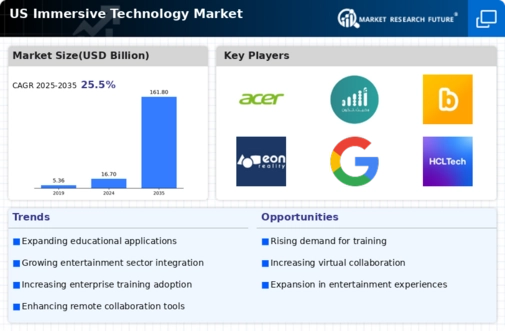US Immersive Technology Market Summary
The United States immersive technology market is projected to experience substantial growth from 16.69 USD billion in 2024 to 203.08 USD billion by 2035.
Key Market Trends & Highlights
US Immersive Technology Key Trends and Highlights
- The market is expected to grow at a compound annual growth rate (CAGR) of 22.95 percent from 2025 to 2035.
- By 2035, the immersive technology market in the United States is anticipated to reach a valuation of 161.8 USD billion.
- in 2024, the market is valued at 16.69 USD billion, indicating a robust starting point for future expansion.
- Growing adoption of immersive technology due to increasing demand for enhanced user experiences is a major market driver.
Market Size & Forecast
| 2024 Market Size | 16.69 (USD Billion) |
| 2035 Market Size | 203.08 (USD Billion) |
| CAGR (2025-2035) | 25.50% |
Major Players
Acer Inc., Atheer, Inc., AVEVA Group PLC, Barco NV, Blippar Ltd., Carl Zeiss AG, CM Labs Simulations Inc., EON Reality, Inc., FAAC Incorporated, Google, LLC, HCL Technologies Limited, Honeywell International, Inc., HTC Corporation, Immersive Media Company, Immersive Technologies Pty Limited, Lockheed Martin Corporation, Magic Leap, Inc., NCTech Limited, Oculus (Facebook Technologies, LLC.), Samsung Group, Sony Corporation, Unity Software Inc., Varjo Technologies Oy, VI-grade GmbH, Zeality Inc.



















